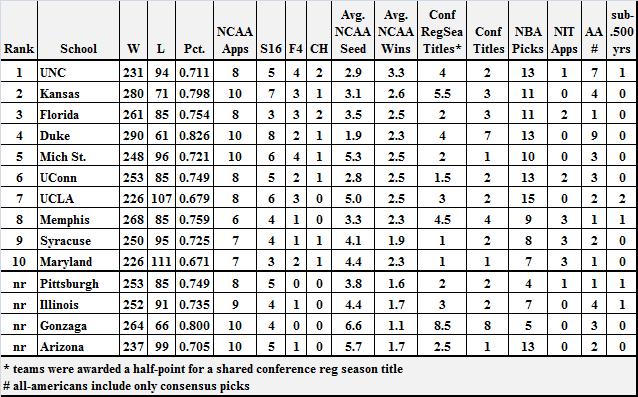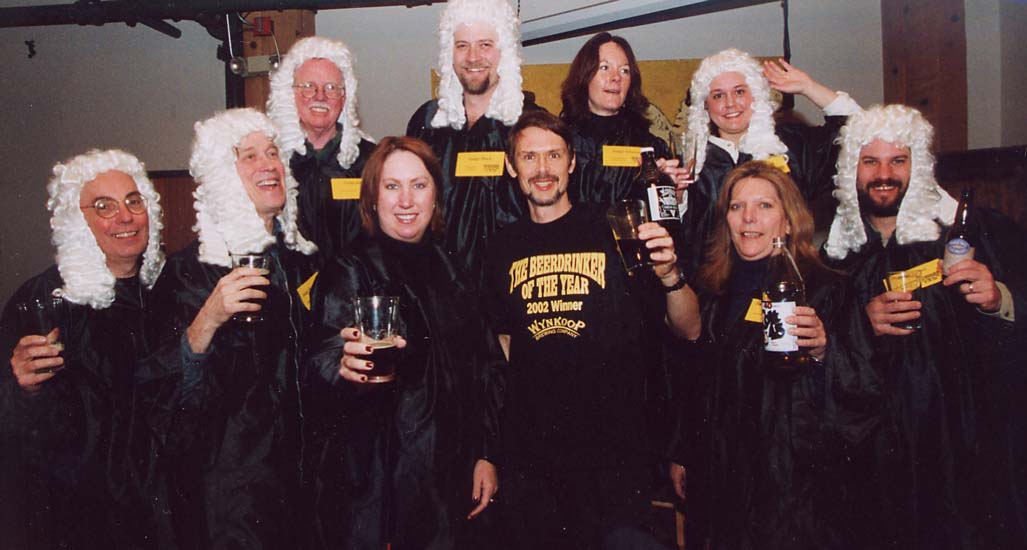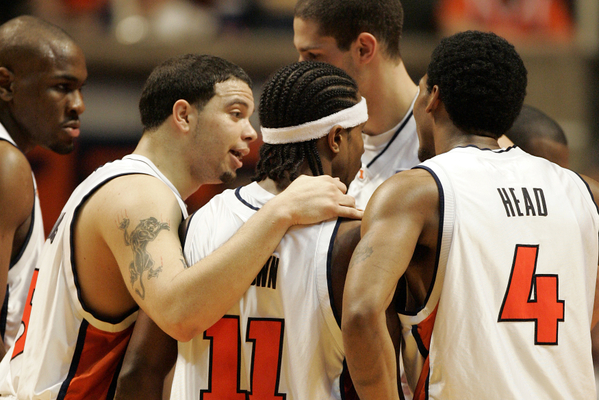
Matt Giles is the RTC correspondent for the Mid-American Conference.
Standings as of 1/29
West Division
- Central Michigan 4-2 9-8
- Northern Illinois 4-2 8-10
- Ball State 4-3 9-9
- Western Michigan 3-3 11-8
- Eastern Michigan 2-4 10-9
- Toledo 0-6 3-17
East Division
- Akron 4-2 14-6
- Kent State 4-2 13-7
- Buffalo 3-3 10-6
- Bowling Green 3-3 10-8
- Miami OH 4-3 6-13
- Ohio 2-4 11-9
Superlatives
Team of the Week Ohio: After starting the conference season 0-4 against East Division foes, the Bobcats erupted from the three-point stripe in their only two games this week. In wins over Northern Illinois and Toledo, Ohio shot 46.7% from deep and dropped 99 points over both squads (it also helps that NIU and Toledo are two of the weakest defensive teams in conference play). Upcoming road games against Toledo and Eastern Michigan should prove whether Ohio is ready to blitz the conference in February; the road has been the Bobcats’ bugbear all season (3-6).
Player of the Week David Kool, Western Michigan: Not only does the 6-foot-3 guard lead the Broncos in PPG (20.1), three-point FG percentage with at least 25 attempts (38.2%) and offensive rating (121.9), the senior now also owns WMU’s career scoring record. In a loss to Akron Wednesday night, Kool dropped 30 and broke Manny Newsome’s 46-year old record. Kool currently has 1,790 points in his career and it’s conceivable he could break the 2,000 point barrier: five of WMU’s final 10 games are against teams allowing more than one point per possession.
Game of the Week Kent State 87, Akron 70: A grudge match between the top two East Division contenders? Check. A nationally televised game? Check. A 17-point loss … what? The last time a game between these two rivals was decided by 17 points or more was in the 2008 MAC championship game (won by the Golden Flashes). The Zips were outmanned on the boards, 38-28, and consequently, in a game where Akron suffered more than a few scoring droughts, Kent State’s 23-11 second chance points were too much to overcome.
Games of the Upcoming Week: Eastern Michigan at Miami, January 30, ESPNU, and Buffalo at Central Michigan, February 4. Central Michigan continues their East Division swing and will want to end the East Division’s dominance of the garnering the NCAA tournaments’ auto bid. A West Division team hasn’t made the Dance since 2005 (Central Michigan). One of the final ESPN-televised games on the MAC slate, the Miami-Eastern Michigan tilt will be the final chance — barring a run through the conference tournament — to see Miami’s Kenny Hayes live in action.
Superlatives: On January 20th, Miami’s Charlie Coles won his 217th game at Miami and is now the MAC’s all-time leader in career conference wins. Coles passed the record previously held by Darrell Hedric, who was a former coach at Miami.
Team Roundups
Central Michigan
Looking Back: The Chippewas had a topsy-turvy week. First, CMU hosted Northern Illinois and managed a win against an intra-divisional foe, 81-75. CMU ‘held’ NIU’s Xavier Silas to 26 points and Robbie Harman continued his impressive three-point turnaround, hitting 3 of 13 from deep. Harman is the best long-range shooter on the Chippewas this season and has upped his percentage from 34% to 42.8%. On Thursday, CMU started their East division swing with intentions of proving they are a contender in the conference, not just in their own division. Falling to Miami didn’t help their plans; CMU has held opponents to a scant 59.7 ppg in 2010 but the RedHawks managed to score 64 points — four more than their conference average.
Looking Ahead: As previously stated, Central Michigan continues its play against East division foes, taking on Bowling Green, Buffalo, Kent State, Akron and Ohio. Second-place Northern Illinois is on a similar swing so if the Huskies struggle and CMU can finish the six-game trip with at least three wins, they could begin to distance themselves within the division.
Northern Illinois
Looking Back: Xavier Silas continues to rise up the MAC scoring ranks, totaling 57 points in two games (26 against CMU, 31 against Ohio). The junior transfer is now averaging 23.5 PPG – best in the conference – and the 6-foot-5 guard is tops in the conference in percentage of possessions used (32.0%) and percentage of shots taken (33.5%). NIU is not just a one-man team: Darion Anderson is 17th in the conference with a 12.0 ppg and the Huskies could become a dangerous team if sophomore Mike DiNunno emerges as a third option. The 5-foot-11 guard rang up 16 on Ohio. However, if Northern Illinois wants to unseat Central Michigan and run away with the East division title, the Huskies need to step up their defense. Sure, the Huskies are the second best at FG defense but they are the third-worst defensive team in the MAC, allowing opposing teams to drop 71.3 PPG. With Silas in the midst of a hot streak, NIU needs to focus on locking teams down.
Looking Ahead: NIU begins its East division swing and will take on the likes of Buffalo, Kent State, Akron and Miami. Look for at least three of the four games to be offensive affairs: Kent State, Buffalo and Akron all rank in the top five in terms of conference scoring offense while at the same time, ranking in the bottom half in scoring defense. If Silas continues to up his scoring average, he could be the first player to average more than 20 a season since John Bowler (20.1) of Eastern Michigan in 2005-06.
Ball State
Looking Back: For as long as Ken Pomeroy has kept his statistical database running, Ball State has cared little for defensive efficiency. In what technically should be considered Billy Taylor’s second ‘real’ season at the helm (don’t forget, he was dealt a rough hand when he took the job in 2007-08), Taylor has remade the Cardinals into the best defensive team in the MAC and overall as well (21st in the nation). Although their overall and conference records may not reflect their defensive superiority, Ball State has allowed only two teams to score above 70 points this season (Valparaiso and Tennessee Tech). Since scoring a meager 38 points against Central Michigan over two weeks ago, the Cardinals have been on a tear, winning four out of five games through defensive prowess. Just ask Miami and Buffalo (Ball State’s two wins this past week); the Cardinals held both squads under their season FG percentage (Miami 32.2%, normally at 42.6% and Buffalo 36.7%, normally at 41.7%).
Looking Ahead: Ball State is definitely the sleeper team in the West division (side note: should it really be surprising though? The Cardinals tied for the West division title in 2008-09) and will get a chance to showcase their defense when the Cardinals visit Ohio on Sunday. The Bobcats recently reeled off consecutive 99 point efforts and are the top scoring team in the conference.
Western Michigan
Looking Back: As we have already detailed, David Kool was RTC’s player of the week in the MAC. His 30-point effort against Akron wasn’t good enough for the win but the senior is on pace to break 2,000 points in his career. Even UA coach Keith Dambrot was impressed, saying he wanted a David Kool Western Michigan jersey. WMU did manage to get a win this week, defeating winless Toledo in Kalamazoo. Although the game was never in doubt, Bronco fans did get a chance to see what 2010-11 starting lineup will be; freshmen Nate Hutcheson scored 15 and Flenard Whitfield scored 11.
Looking Ahead: Western Michigan is in the middle of the pack in the West division and the MAC overall and they better start harvesting those wins quickly. Next season will undoubtedly be a rebuilding year as the Broncos will be losing David Kool, Donald Lawson and Martelle McLemore after this season (aka three of WMU’s top five scorers). If the Broncos want to send those seniors out with a memorable bang, they need to have a strong East division swing that starts Saturday at Kent State followed by a Monday affair at Buffalo.
Eastern Michigan
Looking Back: With Carlos Medlock completely healed from his injury that sidelined the guard the entire 2009 season, EMU was expected to compete in the MAC’s East division. Unfortunately, that hasn’t really happened. Medlock resumed his spot running the offense so EMU’s tempo has risen (62.4 possessions per game to 69.3) but for an experienced team, the Eagles have had their problems on the road – only two of their eight games on the road have been wins. However, since both games this past week were at home, EMU was not affected by the road jitters. Another disturbing trend, though, has emerged and that is the Eagles’ lack of defense. In their loss to Bowling Green, Eastern Michigan allowed the Falcons to connect on 49% of their FGs. In fact, opposing teams have shot well above 40% from the field in most of their nine losses. One positive to take from this past week: Brandon Bowdry is performing like a star. The junior is a rebounding machine, grabbing 28% of opposing teams’ misses and in the two-game span (a win over Ball State and the loss to BGSU), Bowdry averaged 7.1 RPG. The 6-foot-6 Bowdry does need to work on his free throw shooting though; Bowdry is fouled just over 6 times per game but only shoots 50.4% from the stripe. One has to wonder if the team’s woeful FT percentage (65.9%) has contributed to some of their losses.
Looking Ahead: Eastern Michigan could pick up a few games this week against Miami and Akron. We have already mentioned the rebounding force that is Brandon Bowdry. Miami and Akron both struggle with offensive rebounds and EMU could have a field day thanks to second-chance points as well as quick run-outs after missed shots.
Toledo
Looking Back: According to Ken Pomeroy, the Rockets — still winless in conference play – have a 40.5% chance of going winless in conference play. That is second-highest percentage among still-winless teams (Fordham leads with a 61% chance). The second half has doomed Toledo all season in conference play and it continued to hurt UT in losses to Western Michigan and Kent State this week. Although Gene Cross’ crew has struggled has never led after the first half either, they were outscored by a combined 15 points in the two games. Toledo is having a tough time breaking out of the cellar in most MAC offensive and defensive categories. The Rockets are last in scoring offense, FT and FG percentages, offensive rebounds, assists, steals, turnover margin and assist-to-turnover ratio. Basically, it has been a bleak winter in Toledo.
Looking Ahead: Tilts against Akron, Bowling Green and Ohio dot Toledo’s upcoming schedule and, barring an unforeseen upset, it doesn’t look like the Rockets will have enough offensive juice to keep these teams. Even Bowling Green, which ranks in the bottom half of scoring offense, still manages to average 12.2 more PPG than Toledo (61.2 to 49.0).
Akron
Looking Back: We have already mentioned that Akron lost this past week to Kent State due to their inability to corral defensive rebounds. In fact, this has been the Zips’ bugbear the entire season. Akron only grabs 22.8 defensive rebounds a game, good for ninth in conference play. Even though Zeke Marshall has helped on the glass, the Zips are still a smaller than average team. However, Akron is a deep team but will only succeed depending on how well the brothers McKnight (Brett and Chris) play. Against Kent State, Chris played well and scored 13 points while Brett struggled, connecting on only 1-6 from the field. In their win against Western Michigan, though, both Chris and Brett scored in double-digits.
Looking Ahead: According to Coach Dambrot, the MAC is becoming a balanced conference as well as developing into a much more competitive league. That being said, Akron’s next three games (against Toledo, Eastern Michigan and Northern Illinois) are all at the James A. Rhodes H&PE Building so a four-game winning streak (counting last week’s win over WMU) is definitely not out of the question.
Kent State
Looking Back: Across the board, Kent State is a very good team. Whether it’s scoring (fourth in the MAC with 70.2 PPG) or defending the goal (third with 60.7 PPG), Kent State seems like an early favorite to make the MAC tournament championship game. A 87-70 win over Akron – a top team – confirmed that an auto bid could be waiting for the Golden Flashes after the season as they pounded the glass to a tune of 34-27. Then, Kent State handled Toledo, 60-49 – a team it should beat but could have become a trap game (especially after the big win over Akron).
Looking Ahead: Kent State is the second-best team in the MAC from the field, connecting on 44.6% in conference play. However, a Monday tilt against Northern Illinois could snakebite the Golden Flashes. Although we have noted NIU is not a good defensive team, they are the second-best team in field goal percentage defense, allowing opponents to shoot a meager 39%.
Buffalo
Looking Back: Although Buffalo may not be the most offensively efficient team in the MAC (100.8 points per possession), the Bulls have phenomenal ball-handling skills. Buffalo leads the conference in assists (15.17) and assist-to-turnover ratio (1.15) and is second in steals (8.0) and turnover margin (+1.83). So how did they lose both games (Ohio, 99-77 and Ball State, 75-69) this past week? The loss to Ohio is easy to explain: the Bulls turned the ball over 15 times (second most TOs by Buffalo in a conference game in 2010) and the fast play of the game also meant that leading scorer Rodney Pierce (18.1 PPG) would take a lot of shots. Problem is, he attempted 20 and only made six of them. Against Ball State, Buffalo didn’t turn the ball over nearly as much (six times) but apparently, on the way home from Athens, they forgot how to play defense. Ball State skewered Buffalo’s man D and connected on 55.5% of their shots.
Looking Ahead: The Bulls travel to Northern Illinois on Saturday and if UB against forgets how to play defense, it could be a long afternoon (and one guaranteed to keep the statisticians at the Convocation Center busy for a full two hours).
Bowling Green
Looking Back: It’s a miracle Bowling Green was able to pull out a win at Eastern Michigan (64-61). The Falcons have been the MAC’s best free throw shooting team in conference play (76.7%) but against EMU, their shaky FT shooting almost doomed them: 8-13 from the line. The 64-52 loss to Miami offered BGSU fans a glimpse of the future as sophomore Dee Brown scored 17 points off an impressive 3-5 shooting from deep. Three-point shooting has become Bowling Green’s forte; in 2009, the Falcons were third in conference play while in 2010, they have moved to first thanks to Joe Jakubowski (55%) and Brown (52.4%).
Looking Ahead: Expect a plethora of threes when Bowling Green matches up with Central Michigan on Saturday. The Falcons are eighth in the conference in guarding the long ball at 35.3% (but strangely, are the best when it comes to shooting from deep with a 40.4%) while the Chippewas shoot 37.5% from deep. If the statistics prove correct, CMU’s Robbie Harman, Brown and Jakubowski could all have career days. If BGSU does fall to CMU, at least they have Toledo next on the schedule.
Miami
Looking Back: Two wins and a loss are nice but even better was the milestone coach Charlie Coles reached. In a conference that is one of the oldest in college basketball, Coles’ feat is a testament to one of the better coaches in the game today whose teams continually thrive against BCS conferences.
Looking Ahead: Under Coles, Miami is a very good team at blocking shots. They lead the conference with over four per game and their block percentage is ranked 113th in the country (10.1%). Miami’s next two opponents, Eastern and Western Michigan, conversely, get blocked a lot (EMU 8.8% and WMU 10%) so the next two games should be fun times for Antonio Ballard and Adam Fletcher, who both rank in the MAC’s top ten for blocked shots.
Ohio
Looking Back: Ohio was RTC’s team of the week in the MAC and we have already detailed the offensive juggernaut that the Bobcats have become. If their offensive onslaught continues, Ohio and Ball State could wind up the teams in the MAC tournament no one wants to face.
Looking Ahead: On Sunday, opposing basketball strategies will collide. The top ranked offensive team (Ohio) will take on the top ranked defensive team (Ball State) in what should be a widely-watched game … if only the game was televised.
















































